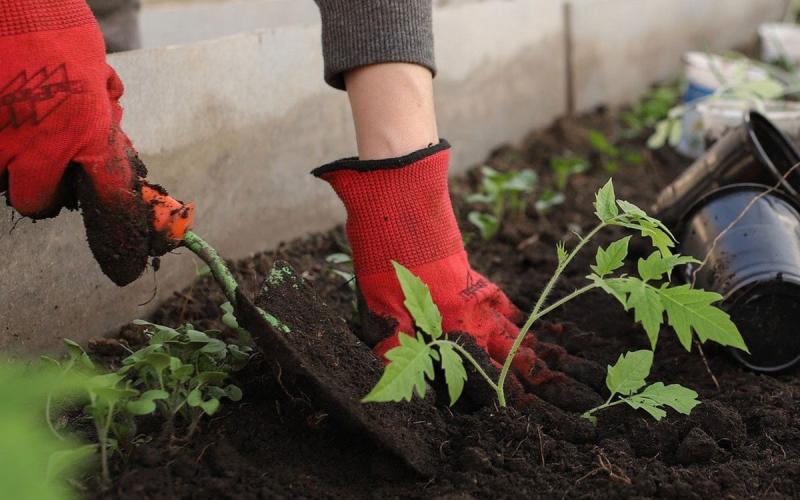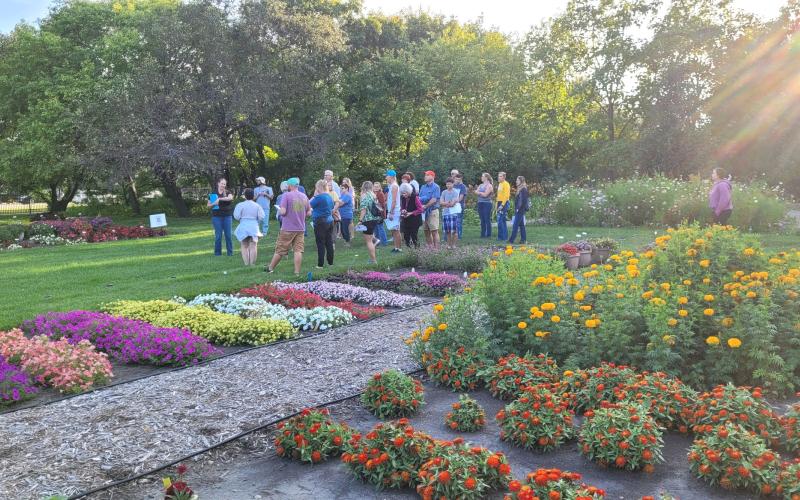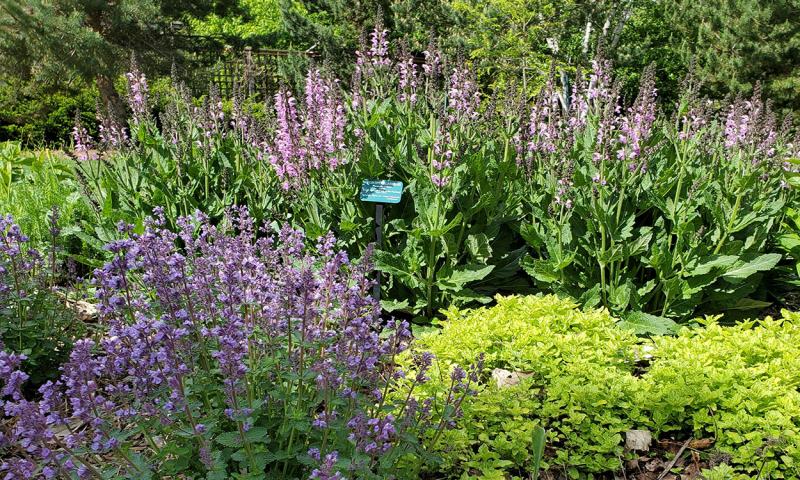
Original article by David Graper, former South Dakota State University (SDSU) Extension Horticulture Specialist & Master Gardener Program Coordinator. Updated by Kristine Lang, SDSU Assistant Professor and Extension Consumer Horticulture Specialist.
Herbaceous perennial plants have long been the mainstay of most gardens. They are grown for their color, fragrance, texture and form (Figure 1). Sometimes we grow certain perennials because they were part of our parents’ and grandparents’ yards and lives. We grow perennials for their functional aspects, like controlling erosion, creating outdoor rooms, screening views and to enhance other aspects of the landscape. We also grow perennials because they are a good investment in the landscape, coming back to grace our gardens for many years to come. Whether you are starting a new perennial garden or adding a few plants to an existing garden, planning and proper planting techniques are key.
Planning Your Garden
Preparing a New Garden
Starting a completely new perennial garden gives you the opportunity to start with a “clean slate.” This often takes advance planning to be the most effective. Be sure to measure the area where you plan to start your garden, so you know how much space you have for placing plants within the area. A sketch or map of the area is often helpful so that you can mark where you might like to place plants in a garden. Also, bringing a simple map of your garden plan to a local garden center will allow employees to help you select plants based on the amount of space that you have. When starting a new garden, it is helpful to begin the autumn before garden establishment to get rid of all the existing plant materials that you do not want to be a part of your new garden. Proper weed control during new garden establishment will prevent future issues.
Assessing an Existing Garden
First, assess the garden to see how many plants from last year are coming back. That will help you decide whether there are any holes to fill in with new plants. Cool spring weather may have delayed emergence of perennials, so do not give up on them right away. They might still emerge when the soil warms up more a little later in the spring. Hibiscus, for example, may not start showing signs of life until early June. Hopefully you have some labels by your plants to aid you in finding them, or you can look for the old stems from last year to tell you where they were growing. It is okay to remove the bigger, old plant debris now by cutting the stems off down close to the ground. If you leave some of the smaller leaf litter behind, it will act as mulch and also provide some nutrients and organic matter to your plants. Once you have a better idea of how much space you have, and what the sunlight conditions are, you can start thinking about what kind of plants you might want to buy to replace the ones you lost.
Light Requirements
The amount of light a garden site receives is often one of the most-important criteria for selecting appropriate perennial plants. A full-sun location should get at least six to eight hours of sun per day; a part-sun location usually gets four to six hours of sun per day while a part-shade location will get less than four hours of sun per day. A shade sun location may include dappled sun, like you would get under some tree branches. A full-shade location will get less than two hours of direct sun per day. Plant height and spread are also very important considerations.
Height and Spread
As you consider plant placement in your garden, think about how tall you would like each plant to grow. It is usually best to have taller plants toward the back of a bed or in the center of a bed that is observed from multiple sides. Plant shorter plants closer to the front of the bed. You can refer to plant tags, merchandising signs, garden center employees and credible reference guides for information on mature plant height and spread. Keep in mind that the plant spread listed usually refers to mature spread, not how large a plant may grow in just one season.
Hardiness Zones
Before you head to the garden center, make sure you know your plant hardiness zone for where you live. Plan to only purchase plants from the appropriate zone. This will give you the greatest chance of enjoying your perennials for years to come.
Plant Selection
When you get to the garden center, you might be tempted to buy one of each potted perennial. It is like going grocery shopping when you are hungry. You are better off to make a list of what you need, or in the case of plants, a list of the sites for which you need plants. However, most gardeners end up getting at least a few plants that they really have no idea where they will plant when they get home. They just carry them around the yard until they find a spot to tuck them in. Some gardeners have a “master plan” of their garden and know exactly what they want. Incorporating new plants into a garden is a balance of planning and having fun with something completely unexpected.
Planting & Care
Hardening Off
When you purchase plants from a retail center, do not rush to plant them without a plan. Even though you bought perennial plants that should be hardy to your area, they will somewhat tender if they go straight from a warm greenhouse to outdoor conditions, especially early in the spring. You should harden perennials for several days prior to planting. Set potted perennials outside in a partially shaded location in the morning and take them back inside for the night. You will be adapting your new plants to outdoor temperatures, wind and higher light levels. Make sure you carefully monitor watering of potted perennials while they are being hardened. Often these plants can be large for the containers they are growing in and may need watering every day or two.
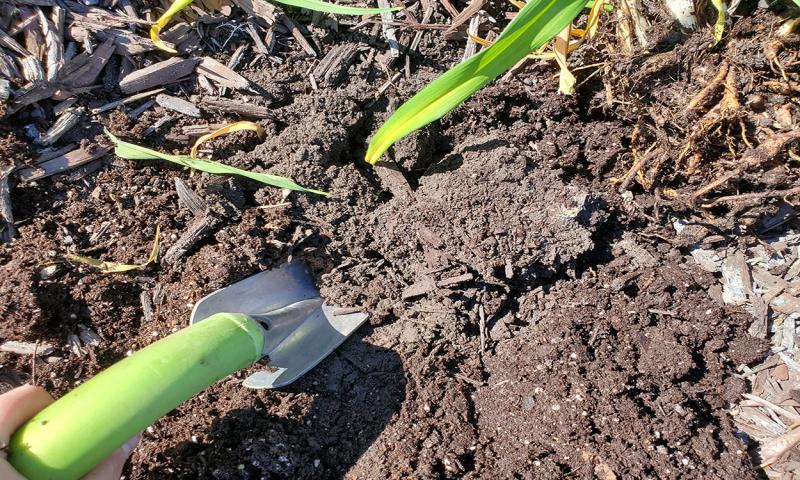
Placement
Planning the placement of your new plants in the garden takes some forethought, as it’s easier to plan ahead than have to dig out and move plants a year later. Lay out your plants on the ground, where you want to plant them. It is easy to move them around and try different arrangements. A common mistake is to put too many plants into a garden bed when they are young, so remember to account for mature plant height and spread two or three years after planting the garden. Plants that produce runners, rhizomes or stolons will spread more rapidly than plants that tend to have a main central crown and that only increase in size slowly over many years. Each gardener will have different preferences for how “full” they want their garden to look.
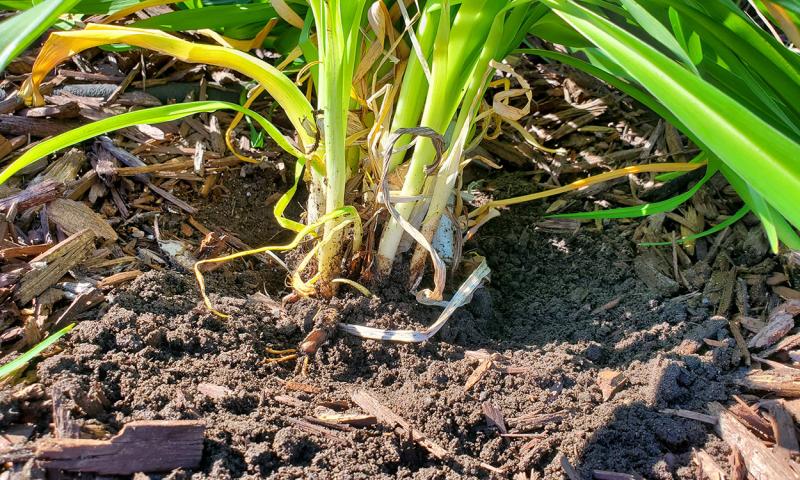
Transplanting
Once you know where you want new perennials to go in the garden you can begin transplanting. Remove any plant debris or mulch on the soil surface, then use a sturdy garden trowel to dig holes for your new plants (Figure 2). Make the holes large enough to easily accommodate the size of the pot. If you make the hole a little wider, you will make it easier for your plant to establish new roots more quickly. Do not make the hole too deep - if you bury the crown of the plant too deeply it could rot, or stunt plant growth. Usually, you can plant the top of the potted soil root ball even with the soil surface to ensure proper planting depth. Firm the soil around each plant to ensure that there is enough soil in place – you do not want your planting to result in depressions around each plant (Figure 3). You also do not want to root-ball sticking above the soil surface after the soil is settled.
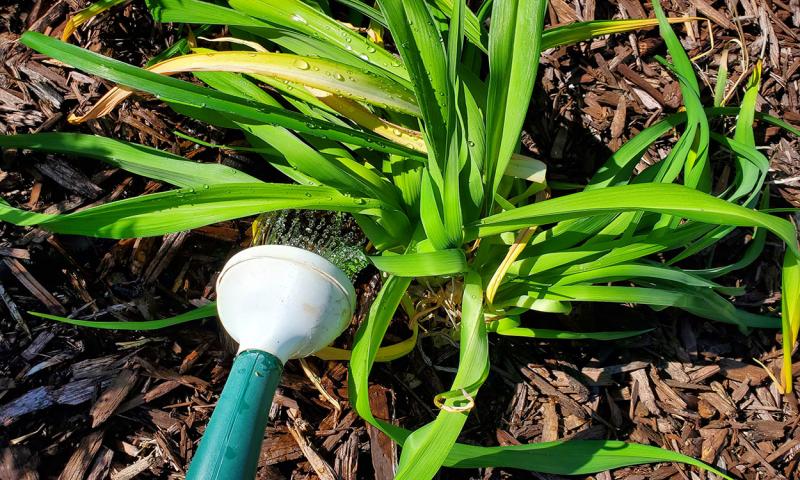
Watering
The last and very important step is to water each new plant thoroughly. Using a hose with the water pressure turned down or a “breaker” or “rose” on the end of the hose or wand can reduce the force of the water and avoid washing out the soil. You can also use watering can if you are only adding a few plants to the garden. No matter how you water, do not “blast” the plant or force soil away from the roots. Water right at the base of each plant so that you help to get the soil settled in around the roots (Figure 4). If you just stand back and water a bunch of plants at once, it will not be as effective – focus on giving each new plant a good soak. You will need to continue to water newly plant perennials more frequently than established plants because their root system will take time to spread deeper into the soil.
Mulching
If you want to reduce watering and prevent weeds, consider adding mulch to your perennial garden. Wood mulch is a tried and true organic mulch. It stays in place in the garden, looks attractive and moderates soil temperatures in addition to the previously mentioned water and weed benefits. Apply the mulch about four to six inches deep to be effective. You do not need to apply a weed barrier fabric first when using shredded bark or wood chips as the material will gradually break down over time and can add organic matter to the soil. Even though rock mulch is quite popular, it can be problematic as a mulch, especially for annuals and perennials. Besides being heavy and difficult to work with, rock mulch heats up during the summertime causing stress to most perennial plants. While many think it is a low maintenance alternative, weeds frequently grow in rock mulch as the weed seeds are blown in between the rocks. If you are really interested in having healthy perennial plants, an organic mulch is a much better option.
Special thanks to SDSU Extension Master Gardeners Tim Schreiner and Stacy Dreis for serving as volunteer copy editors of this article.
